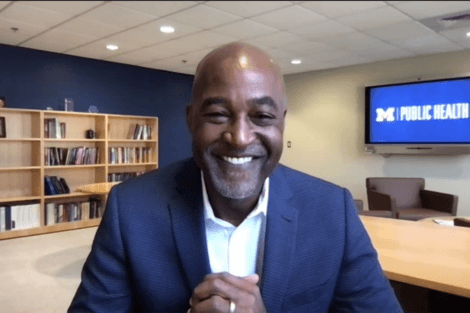December 8, 2020 – The University of Michigan School of Public Health has spent the past 10 months immersed in responding to the COVID-19 pandemic, said F. DuBois Bowman, dean of the school and keynote speaker at Harvard T.H. Chan School of Public Health’s Alonzo Yerby Fall Diversity Lecture in Public Health on December 3, 2020.
“The public health perspective has been needed internally within our respective universities, locally within our neighborhood counties, districts, and states, as well as globally across diverse populations,” said Bowman.
He added that the global pandemic has highlighted “the significant societal impacts when public health isn’t prioritized and working optimally. In many ways, 2020 has been the year of public health.”
Harvard Chan School Dean Michelle Williams introduced Bowman and spoke about the importance of the Yerby Lecture series, which brings minority scientists and scholars to the School to speak on important health topics. The lecture is named for the late Alonzo Smythe Yerby, MPH ’48, who was the first African American department chair at the School. Bizu Gelaye, assistant professor in the Department of Epidemiology, moderated the event.
Bowman, an expert in the statistical analysis of brain imaging data, spoke about the role that his school of public health has played during the pandemic as well as the issue of firearm safety.
The University of Michigan School of Public Health’s activities during the pandemic have included modeling disease spread, helping the university monitor COVID-19 on campus and develop safety guidelines, collaborating with Michigan officials on tools such as a symptom tracking app and a data dashboard, and working with a group of health and business leaders to discuss how to safely reopen the state’s economy after a spring shutdown, Bowman said.
On the topic of firearm safety, Bowman cited worrisome U.S. statistics about gun-related deaths and injuries. He noted that firearms cause roughly 100 deaths per day across the country, and that, from 2008–2017, they were the number two leading cause of youth fatalities (the number one cause was motor vehicle crashes). In addition, he said, although the U.S. has only 3.5% of the world’s children, it accounts for 90% of child firearm deaths across the globe.
Bowman said that firearm fatality rates are “getting worse, not better,” and pointed out racial and ethnic disparities. For example, firearms have been the leading cause of death among African American youth for decades, he said.
“It’s clear that we’re losing too many people on an annual basis, there are too many injuries, and it requires a public health response to tackle it,” said Bowman.
